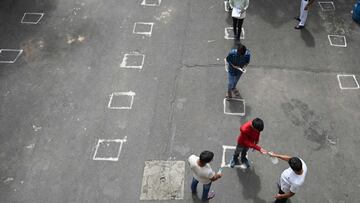American Association of Pediatrics Covid-19 School Guidance: Should children wear masks?
As school districts rush to figure out how to reopen schools this fall, the American Association of Pediatrics published guidance to help in the process.


Teachers and administrators across the country are in a race to get schools ready to reopen safely this fall. With only children twelve and older eligible to receive a covid-19 vaccine, school districts have had to get creative on how to keep children, teachers, and staff safe from the virus.
The American Academy of Pediatrics (AAP) released guidance to assist in this effort. The AAP states that the guidance was developed to provide evidence-based suggestions to “support communities, local leadership in education and public health, and pediatricians collaborating with schools in creating policies for safe schools during the COVID-19 pandemic.”
Researchers have found that as long as schools abide by the guidance released by the World Health Organization and the CDC, “Opening schools generally does not significantly increase community transmission.”
With evidence on low in-school spread of SARS-CoV-2 with masking and other prevention measures & availability of vaccines for ages 12+, the AAP says benefits of in-person school outweigh risks in almost all circumstances. https://t.co/EfRhiJd8TG pic.twitter.com/MQHN4tK5RJ
— AAP News (@AAPNews) July 19, 2021
How does the AAP suggest policy to protect students, teachers, and staff are developed?
The AAP recommends that school districts, counties, and states “develop strategies that can be revised and adapted depending on the level of viral transmission and test positivity rate throughout the community and schools.” These “strategies” should account for “differences between school districts, including urban, suburban, and rural districts.”
The organization also advises that these policies be flexible to allow for adjustments when they do not seem to be working or if new information about the virus becomes available. These policies should also account for all the public health tools at their disposal including, “vaccination, universal mask use, ventilation, testing, quarantining, and cleaning and disinfecting.”
Masks
As it related to masks, the guidance suggests that “students older than 2 years and all school staff should wear face masks at school.” The AAP included universal mask-wearing in their guidance because many children are ineligible for vaccination. Also, there are not many systems that would allow schools to verify students have received their shots.
The @AmerAcadPeds urges in-person learning, universal masking in updated guidance on safe schools. https://t.co/1b72NxDqW8 pic.twitter.com/JOZMPT3cOX
— AAP News (@AAPNews) July 20, 2021
Additionally, as the delta variant continues to drive up cases in the US, low vaccination within the surrounding community could make schools transmission hotspots. While not able to limit all transmission, masks do help to slow the spread of the virus.
Read more on the delta variant
- Will unemployment payments restart due to the covid-19 Delta variant?
- Dr. Fauci says vaccines effective at protecting from Delta variant
- Coronavirus US: why the covid-19 Delta variant is more dangerous
Testing
All members of the campus community should have access to fast, reliable testing. If a positive case is found, those in close contact must be alerted and tested quickly to avoid further spread.
The AAP warns that while there are no major differences in how covid-19 presents itself in younger and older children, “some symptoms such as body aches, shortness of breath, and loss of taste/smell are more prevalent in young adults than in school-aged children.”
Vaccination
Related stories
The CDC and FDA cleared the use of the Pfizer and BioNTech vaccine for children between the ages of twelve and seventeen. The AAP encourages all parents with children in this age group to get their children vaccinated. The most common side effects are “pain at the injection site, fatigue, headache, chills, muscle pain, fever and joint pain, consistent with trials in older teens and adults.”
To encourage vaccine uptake among eligible children and their families, schools should consider creating a COVID-19 vaccination clinic. These clinics could be run in the summer and throughout the school year and can consider offering other vaccines other than ones for covid-19. Offering other vaccines such as polio, measles, and whooping cough can help parents who may have fallen behind on their children’s vaccinations throughout the pandemic.
- Mascarillas
- Material sanitario
- Consejo escolar
- Ciencia
- Coronavirus Covid-19
- Colegios públicos
- Pandemia
- Coronavirus
- Enseñanza pública
- Colegios
- Virología
- Epidemia
- Enfermedades infecciosas
- Centros educativos
- Comunidad educativa
- Microbiología
- Enfermedades
- Asistencia sanitaria
- Medicina
- Sistema educativo
- Sanidad
- Educación
- Biología
- Salud
- Ciencias naturales

